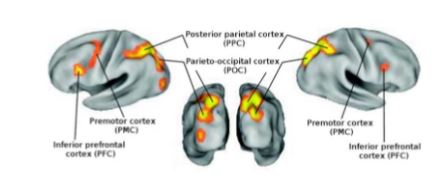Acquisition and Utilization of Mental Imagery Capability in Robotic Action Sequencing Tasks
Main Article Content
Abstract
This work presents a series of neurorobotic models underlying learning in robots. It demonstrates the way in which, during sensorimotor exploration, robots do not just gain knowledge about how to form movement primitives but also obtain a mental imagery capability. Mental imagery plays a key role in these computational models by accelerating learning processes of action sequencing tasks. The first experiment involves permitting a humanoid robot to learn how to retrieve an out-of-reach object using a provided tool. This experiment explores a phenomenon on tool use development found in human infants. In addition, it tests two hypotheses on tool use development. The second experiment extends the domain of robot learning by targeting a useful robotic application. It drives a service robot to learn to acquire knowledge of how to manipulate perceived objects based on the objects’ information and a goal from users. By means of planning, learning the sequence of actions in mind, the robots are able to learn by examining actions’ outcome without really performing actions. This allows the second model to completely exclude parts of overt movements from the training loop. The results confirm that two types of robots can complete their given tasks in a reasonable period of time. The proposed models would benefit robotic applications in terms of online learning.
Article Details

This work is licensed under a Creative Commons Attribution-NonCommercial-NoDerivatives 4.0 International License.
References
J. Connell and S. Mahadevan, Robot learning, vol. 233, Springer Science & Business Media, 2012.
J. Kober, J. Bagnell and J. Peters, “Reinforcement learning in robotics: A survey,” The International Journal of Robotics Research, vol. 32(11), pp.1238-1274, 2013.
B. Argall, S. Chernova, M. Veloso and B. Browning, “A survey of robot learning from demonstration,” Robotics and autonomous systems, vol. 57(5), pp.469-483, 2009.
L. Rat-Fischer, J. K. O’Regan and J. Fagard, “The emergence of tool use during the second year of life,” Journal of experimental child psychology, vol. 113(3), pp.440-446, 2012.
J. Gibson, The ecological approach to visual perception: classic edition, Psychology Press, 2014.
S.M. Kosslyn, Image and the Brain. The Resolution of the Imagery Debate, MIT Press, A Bradford Book, Cambridge, 1994.
N. Thomas, “Mental Imagery”, The Stanford Encyclopedia of Philosophy (Spring 2018 Edition), Edward N. Zalta (ed.), [Online] Available: https://plato.stanford.edu/archives/spr2018/entries/mental-imagery/
J. Piaget, and M. Cook, The origins of intelligence in children, New York: International Universities Press, vol. 8(5), 1952.
A. Stoytchev, “Behavior-grounded representation of tool affordances”, in Robotics and Automation, 2005.
ICRA 2005. Proceedings of the 2005 IEEE International Conference on, (April. 2005), pp.3060-3065, 2005.
V. Tikhanoff, U. Pattacini, L. Natale and G. Metta, “Exploring affordances and tool use on the iCub”, in Humanoid Robots (Humanoids), 2013 13th IEEE-RAS International Conference on, (October. 2013), pp.130-137, 2013.
V. Bentley-Condit, “Animal tool use: current definitions and an updated comprehensive catalog,” Behaviour, vol. 147(2), pp.185-32A, 2010.
J. Fagard, L. Rat-Fischer and K. O'Regan. “The emergence of use of a rake-like tool: a longitudinal study in human infants,” Frontiers in psychology, vol. 5, pp. 491, 2014.
J. Lockman, “A perception–action perspective on tool use development,” Child development, vol. 71(1), pp.137-144, 2000.
B. Kahrs and J. Lockman, “Building tool use from object manipulation: A perception–action perspective,” Ecological Psychology, vol. 26(1-2), pp.88-97, 2014.
E. Gibson and A. Pick, An ecological approach to perceptual learning and development, Oxford University Press, USA. 2000.
F. Guerin, N. Kruger and D. Kraft, “A survey of the ontogeny of tool use: from sensorimotor experience to planning”, IEEE Transactions on Autonomous Mental Development, vol. 5(1), pp.18-45, 2013.
E. Gibson, “Exploratory behavior in the development of perceiving, acting, and the acquiring of knowledge,” Annual review of psychology, vol. 39(1), pp.1-42, 1988.
R. Shepard and J. Metzler, “Mental rotation of three dimensional objects,” Science, vol. 171(972):701-3, 1971.
J. Zacks, “Neuroimaging studies of mental rotation: a meta-analysis and review,” Journal of cognitive neuroscience, vol. 20(1), pp.1-19, 2008.
P. Oudeyer and F. Kaplan, “What is intrinsic motivation? A typology of computational approaches,” Frontiers in neurorobotics, vol. 1, pp.6, 2009.
S. Schaal, “Dynamic movement primitives-a framework for motor control in humans and humanoid robotics,” Adaptive motion of animals and machines, Springer Tokyo, pp.261-280, 2006.
F. Stulp and O. Sigaud. "Policy improvement methods: Between black-box optimization and episodic reinforcement learning," 2012.
V. Tikhanoff, A. Cangelosi, P. Fitzpatrick, G. Metta, L. Natale and F. Nori, “An open-source simulator for cognitive robotics research: the prototype of the iCub humanoid robot simulator,” in Proceedings of the 8th workshop on performance metrics for intelligent systems, (August. 2008), pp.57-61, 2008.
K. Seepanomwan, D. Caligiore, A. Cangelosi and G. Baldassarre, “Generalisation, decision making, and embodiment effects in mental rotation: a neurorobotic architecture tested with a humanoid robot” Neural Networks, vol. 72, pp.31-47, 2015.
C. Watkins and P. Dayan, “Q-learning”, Machine learning, vol. 8(3-4), pp.279-292, 1992.
I.. Sucan and S. Chitta, “MoveIt”, [Online] Available: https://moveit.ros.org


